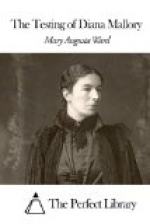But before he arrived Diana took a resolution. She went very early one morning to see Sir James Chide. He was afterward closeted with Lady Lucy, and he went up to town the following day on Diana’s business. The upshot of it all was that on the morning of New Year’s Eve a marriage was celebrated in Oliver Marsham’s room by the Rector of Tallyn and Mr. Lavery. It was a wedding which, to all who witnessed it, was among the most heart-rending experiences of life. Oliver, practically blind, could not see his bride, and only morphia enabled him to go through it. Mrs. Fotheringham was to have been present; but there was a feminist congress in Paris, and she was detained at the last moment. The French specialist came. He made a careful examination, but would give no decided opinion. He was to stay a week at Tallyn in order to watch the case, and he reserved his judgment. Meanwhile he gave certain directions as to local treatment, and he asked that a new drug might be tried during the night instead of the second dose of morphia usually given. The hearts of all in charge of the invalid sank as they foresaw the inevitable struggle.
In the evening the new doctor paid a second visit to his patient. Diana saw him afterward alone. He was evidently touched by the situation in the house, and, cautious as he was, allowed himself a few guarded sentences throwing light on the doubt—which was in effect a hope—in his own mind.
“Madame, it is a very difficult case. The emaciation, the weakness, the nerve depression—even if there were no organic disease—are alone enough to threaten life. The morphia is, of course, a contributing cause. The question before us is: Have we here a case of irreparable disease caused by the blow, or a case of nervous shock producing all the symptoms of disease—pain, blindness, emaciation—but ultimately curable? That is what we have to solve.”
Diana’s eyes implored him.
“Give him hope,” she said, with intensity. “For weeks—months—he has never allowed himself a moment’s hope.”
The doctor reflected.
“We will do what we can,” he said, slowly. “Meanwhile, cheerfulness!—all the cheerfulness possible.”
Diana’s faint, obedient smile, as she rose to leave the room, touched him afresh. Just married, he understood. These are the things that women do!
As he opened the door for her he said, with some hesitation: “You have, perhaps, heard of some of the curious effects that a railway collision produces. A man who has been in a collision and received a blow suffers afterward great pain, loss of walking power, impairment of vision, and so forth. The man’s suffering is real—the man himself perfectly sincere—his doctor diagnoses incurable injury—the jury awards him damages. Yet, in a certain number of instances, the man recovers. Have we here an aggravated form of the same thing? Ah, madame, courage!”
For in the doorway he saw her fall back against the lintel for support. The hope that he infused tested her physically more severely than the agonies of the preceding weeks. But almost immediately she controlled herself, smiled at him again, and went.




